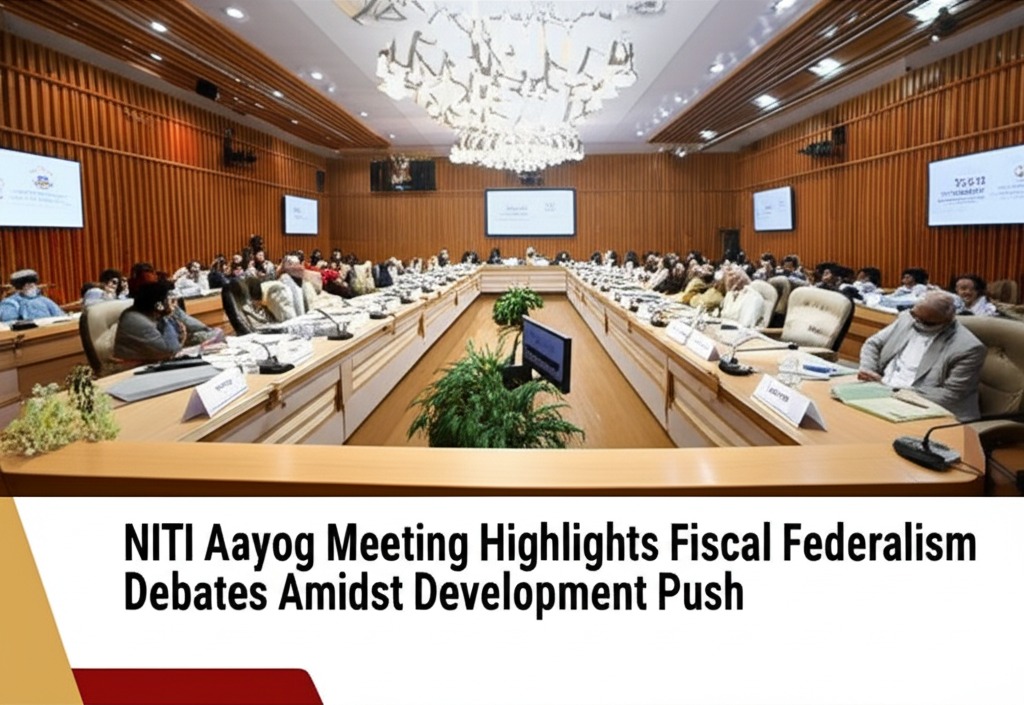NITI Aayog Meeting Highlights Fiscal Federalism Debates Amidst Development Push
Published on May 24, 2025 | Generated by AI
 🤖 AI-generated Image
🤖 AI-generated Image
Why It Matters
The recent NITI Aayog Governing Council meeting, chaired by Prime Minister Narendra Modi on May 24, 2025, brought the crucial subject of Centre-State relations back into sharp focus. The meeting, held under the theme of 'Viksit Rajya for Viksit Bharat@2047', aimed to foster collaboration towards achieving India's ambitious development goals. However, it also underscored existing points of contention between the central government and various state administrations, particularly concerning fiscal autonomy and the equitable distribution of resources. The dialogue involved chief ministers and representatives from states and Union Territories, highlighting the political and economic significance of harmonizing national objectives with regional aspirations. The differing perspectives on how to achieve inclusive growth and empower states are central to this ongoing discourse.
Background & Timeline
NITI Aayog, established in 2015 as a replacement for the Planning Commission, serves as the premier policy 'think tank' of the Government of India, aiming to foster cooperative federalism through structured policy support and initiatives at the state level. Its Governing Council meetings provide a platform for the Centre and states to deliberate on key national development priorities. These interactions are designed to move away from a top-down planning approach towards one that involves states more directly in policy formulation and implementation. While the stated objective is to build a stronger 'Team India' for national progress, the diverse political landscape and varying developmental needs across states often lead to discussions and debates on resource allocation, implementation challenges, and the balance of power between the Centre and states. Such meetings are integral to the functioning of India's federal structure, seeking to align diverse regional strategies with overarching national goals.
What’s Happening Now
- May 24, 2025: Prime Minister Narendra Modi chaired the 10th NITI Aayog Governing Council meeting with the theme 'Viksit Rajya for Viksit Bharat@2047', emphasizing the need for Centre-state collaboration to achieve national development goals. He urged states to focus on developing world-class tourist destinations and creating future-ready cities. This highlights the central government's priority areas for state-level action.
- May 24, 2025: Chief Ministers from several non-BJP ruled states, including West Bengal, Kerala, Karnataka, and Puducherry, were notably absent from the NITI Aayog meeting. Additionally, Bihar CM Nitish Kumar, an NDA ally, also skipped the meeting, sparking political speculation ahead of the Prime Minister's impending visit to Bihar. These absences underscore potential political divergences or protest against the current framework of Centre-State engagement.
- May 24, 2025: During the meeting, Chief Ministers from non-BJP ruled states raised concerns and demanded a larger share of central taxes, alleging "step-motherly treatment" by the central government in resource allocation. This indicates persistent friction over fiscal federalism and the perceived imbalance in the distribution of financial resources between the Centre and states.
- May 24, 2025: Andhra Pradesh Chief Minister proposed the formation of sub-groups within NITI Aayog to focus on key areas such as GDP growth, population management, and technology-based governance. This suggestion reflects a desire for more specialized and focused discussions on specific development challenges and opportunities faced by states.
- May 24, 2025: Prime Minister Modi, while addressing the NITI Aayog meeting, stated that 'Operation Sindoor', India's recent military action, should not be treated as a one-off initiative. This remark, although related to national security, was made in the context of a meeting focused on development and Centre-State cooperation, suggesting the government's intent to integrate national security priorities into broader governance discussions.
What Could Happen Next
-
1. Enhanced Cooperative Federalism: The Centre and states could leverage the NITI Aayog platform for more constructive dialogue and collaboration. By forming focused sub-groups and addressing the concerns raised by states regarding resource allocation and fiscal autonomy, a more harmonious working relationship could develop, accelerating the pace of development across the country towards the 2047 vision. This would require greater transparency and a willingness from both sides to find mutually agreeable solutions to fiscal and policy challenges.
2. Increased Friction and Policy Divergence: Disagreements over tax sharing, central schemes, and the perceived imbalance of power could escalate, leading to increased friction between the Centre and opposition-ruled states. This might manifest in states pursuing independent policy directions, potentially hindering the effective implementation of national programs and creating disparities in development outcomes. Political posturing and non-cooperation could become more prevalent, impacting the spirit of cooperative federalism.
3. Political Realignment Influences Centre-State Dynamics: Changes in the political landscape, including potential realignments of regional parties with national blocs, could significantly impact Centre-State relations. A stronger mandate for the ruling party at the Centre or shifts in state-level power could alter the dynamics of negotiation and cooperation. This scenario could lead to either greater alignment and smoother implementation of policies or intensified political rivalry that further complicates collaborative governance.
This article is generated using AI-assisted summaries and verified timelines.
